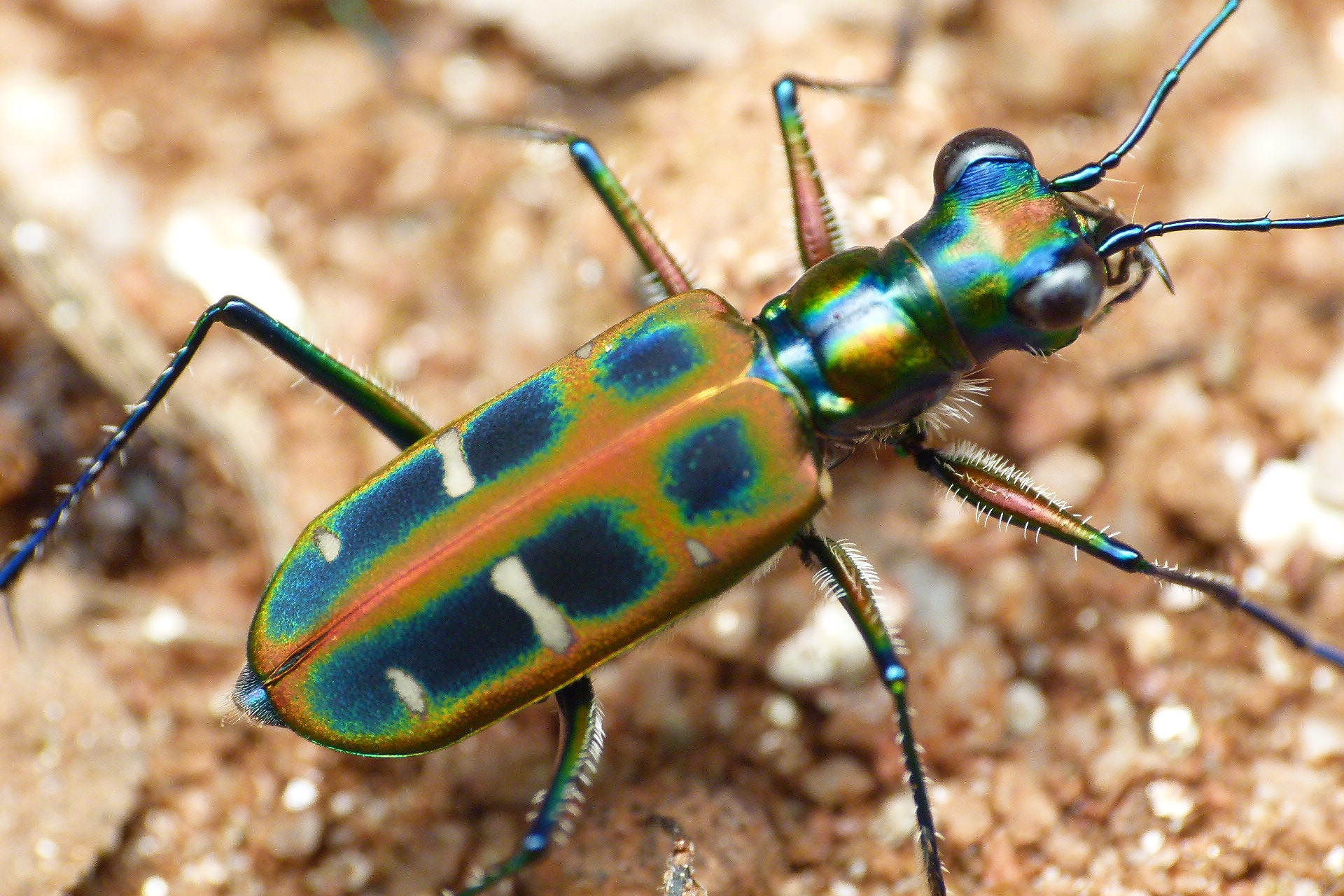 |
| An ultrasound detector |
 |
| C. venus up front |
Cicindelids apparently hear ultrasound using two "ears" on the dorsal side of the first abdominal segment. They respond to bat pulses with escape behaviour and also produce ultrasound at around 30–35 kHz in non-defensive contexts, perhaps for communication. According to one study the production of ultrasound in flight is possibly through a mechanism that involves the elytra and wings. I however wonder if they may be producing other sounds through mandibular stridulation, when not flying. They often seem to gnash their jaws, mandibles crossing over each other and perhaps the micro-structure of the flat mandibular surface will have something to reveal. Someday hopefully we can hear these beetles, who knows they might even be detected and identified by their sounds.
 |
| A regular on forest paths in the Western Ghats Cicindela (Cosmodela) duponti Dejean, 1826 |
 |
| Another view of Cicindela (Cosmodela) duponti Dejean, 1826 |
 |
| Cicindela (Jansenia) venus Horn, 1907 another forest species found on leaf-litter |
 |
| Cicindela (Calochroa) hamiltoniana Thomson, 1857 most times seen on shaded paths close to water |
 |
| Cicindela aurofasciata Dejean, 1831 a stouter species found on open grassy habitats |
 |
| Cicindela (Calochroa) flavomaculataHope, 1831 One of the few species more often attracted to light in the night |
 |
| Lophyra lineifrons, Bandipur (April-2013) [Determined by Michael Geiser] |
 |
| Cicindela (Calochroa) whithilli (Hope) from Talakaveri, Coorg |
 |
| Cicindela (Ancylia) calligramma Schaum, 1861 from near Nandi Hills, Bangalore (15-July-2013) |
 |
| To be determined. Mudigere, 11- May 2013 |
 |
| Cylindera (Eugrapha) sp. Seen in large numbers on sand beside stream (11-May-2013). (Identified to genus by Michael Geiser - 5-Dec-2013) |
 |
| Cicindela (Jansenia) dasiodes Acciavati & Pearson, 1989 (from GKVK, 19-June-2013) |
A feature that makes tiger beetles particularly interesting for those interested in electronic field guides is their patterning. It would appear as if there was a fairly simple archetypal "bodyplan" (what the Germans called Bauplan, but often avoided because of an implicit idea of "design"). An archetypal plan is however possible without any fear of "intelligent design" if one considers that patterns are coded by sections of genetic code, modules of which are shuffled about during the evolution of species. An amazingly old (1917) work on this is by Shelford and he identifies patterns of colour and provides some interesting insights into developmental biology. By subjecting larvae and pupae to specific environmental conditions of temperature and humidity he was able to alter the patterns that form on the elytra of the adults.
Inspired by Shelford, I attempted to look at the patterns on some Indian species. It is however very difficult to see much without access to museums or other collections.
 |
| Patterns on a handful of Indian species - easily drawn using Inkscape |
Acknowledgement
Most of the photos were taken on field trips either accompanied or made possible by Dr. Revanna S. Revannavar, entomologist at the University of Horticultural Sciences, Mudigere.
.
References
- Pearson, DL (1988) Biology of tiger beetles. Ann. Rev. Entomol. 33:123-47.
- Shelford, Victor Ernest (1917). Color and color-pattern mechanism of tiger beetles. Illinois Biological Monographs 3(4):395-532.
- Yager, DD; Spangler, HG (1997). Behavioral response to ultrasound by the tiger beetle Cicindela marutha Dow combines aerodynamic changes and sound production. Journal of Experimental Biology 200:649-659.
Would be terrific if someone can come up with a low-cost ultrasound monitoring instrumentation in India - based on ideas such as this. Would be very happy to help in field testing for any electronic whizzes out there that might be interested.
2020: Much of what I wrote above is obsolete after the publication of a wonderful and ground-breaking fieldguide to the tiger beetles of India - You can buy the book via Amazon India or the publishers.


No comments:
Post a Comment